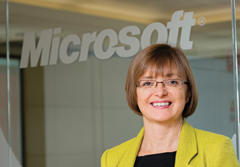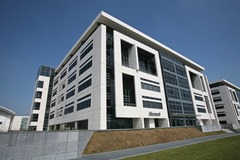A new world
 Microsoft is on a journey from being a product-led company to one focused on devices and services. Cathriona Hallahan, Managing Director of Microsoft Ireland, talks to Owen McQuade.
Microsoft is on a journey from being a product-led company to one focused on devices and services. Cathriona Hallahan, Managing Director of Microsoft Ireland, talks to Owen McQuade.
Microsoft’s Irish operations, have evolved from being a small manufacturing site to a major employer (1,200 employees in Sandyford), covering sales, services development and global logistics. The company also has invested significantly in European data centres in City West in Dublin.
Cathriona Hallahan was one of its first 24 employees back in 1985. After 10 years in finance and 17 in operations, she took charge as Managing Director on 1 February this year.
“The company has totally transformed and has transformed multiple times over that period,” she reflects. “When I started in 1985, there was a manufacturing facility duplicating CDs, packing boxes and warehousing products, and now we are offering devices and services and have data centres with cloud offerings.
“We are doing core development here whereas in the past we would have done localisation of product for the EMEA markets. We are now currently shifting from a product focus to a focus on experiences.”
Cloud services, in her view, are a clear opportunity for government to drive more efficiencies and cost savings. “Everyone in the current economic environment is looking to do things smarter, cheaper and better,” Hallahan notes. “We have been engaging with government in Northern Ireland on opportunities to transform the services to their customers and also how they do their business.”
The Belfast Health and Social Care Trust, for example, had been running six large legacy systems across six acute hospitals and many more smaller branch exchanges in 150 buildings across the city. The trust wanted to “link everyone up” and was able to help its workforce to “communicate more effectively” by implementing Microsoft Lync which lists the staff available at any one time.
Video conferencing has enabled more timely case reviews and therefore quicker decision-making. “From a cost perspective, they have been able to take out legacy infrastructure,” she adds. “It made sense for the trust as they were struggling with their existing infrastructure. This gave them not just a replacement but enhanced capabilities that have changed the way they work.”
Another example of Microsoft working with the northern public sector is the company’s work with Northern Ireland Water. “The water utility had a large infrastructure of servers and a data centre, and didn’t have the space to expand,” she relates.
Northern Ireland Water worked with Microsoft to virtualise its infrastructure, using Windows Server 2008 R2 and moving from nearly 200 physical servers to 24 physical servers and 125 virtual machines. The new infrastructure has not only reduced costs but has allowed the company to scale up its capacity to 44 servers and up to 275 virtual machines.
“The Northern Ireland public sector has a huge amount of best practice and is leading the way, not just in scaling systems but in changing the way people use technology,” Hallahan comments, “particularly in the education sector.”
Third level education students are moving to a device- and service-led environment under 21st Century Campus programme. As a result, all students and lecturers at Belfast Metropolitan College will be moving to Office 365, Lync and Sharepoint under the programme. Office 365 will also be rolled out to all secondary level students in Northern Ireland: “Children now have access to devices and the challenge is: ‘How do you integrate that into the schools?’ Northern Ireland has taken a leadership role in this.”
Is cloud computing starting to change things? “Absolutely,” she replies. “We have been on the cloud journey now for a number of years. For the last two years, we have issued a cloud index report which is really an attempt to get information on the awareness of cloud computing and the adoption of cloud.”
In a significant shift, SME start-ups are seeing cloud computing as “an opportunity to scale their business.” These companies would have previously focused on the market which they were going to initially serve (mainly in the UK and Ireland). They now see cloud computing and the internet as a way of accessing global markets.
Adoption of the cloud has been slower in the public sector and in large enterprises because of concerns around security and privacy. “There is a role for government in alleviating some of those concerns,” Hallahan remarks. “There is also a role in educating organisations in classifying their data – it is not one-size-fits-all. Guidelines would help to identify what data can be placed in the cloud and how it can be leveraged to drive efficiency.”
Data classification, in her view, is key in deciding “what you want to keep private, what you want in the cloud and how you can have data transmitted between both, when it makes sense.” A good example of this is road traffic camera data which can be stored in the public cloud (because it is public data) but can be brought back into the private cloud when it is needed for a road traffic accident investigation.
Hallahan adds: “We are sitting down with a lot of our large customers, including banks and large enterprises, and having conversations around classifying data and what they are using it for. And how cloud is an option for their business.”
Digital engagement
Microsoft has also focused on digital engagement between organisations with customers and citizens. One example of this has been its work with An Garda Síochána.
“With the change in community policing and the recent consolidation of Garda stations, we have been working with the Garda to create a community app to allow people to get access to services,” she explains. “It is about driving digital engagement as a way of outreach to citizens and to provide enhanced services.”
The company’s own workforce is “getting more mobile” with employees being given more flexibility in their working environment. “Many companies now have work-from-home and flexible working hours arrangements. Technology is a great enabler for this type of working,” she says.
“Microsoft Lync gives access to presence no matter your location. I can have Lync on my phone and people can instant-message me and I don’t have to be logged onto my computer. It is agnostic of any device and you can have access to all your data and people can have access to you.”
Skydrive and Skydrive pro are used to share documents and update fellow team members, and give a staff member access to all their work data. “We now have a very flexible working environment with a fully open plan office and no assigned desks,” Hallahan comments. “You can work here or at home. As a result we save 30 per cent on our office footprint.”
A recent visit by a public sector organisation highlighted Microsoft’s managed printing service. “On one floor,” she notes, “we have 250 people sharing five printers whereas that organisation has 1,100 people with 900 printers. This resonated with the visitors who came away with the thought that you can work in a totally different digital environment.”
With such a fast changing sector, though, surely it is difficult for customers to make investment decisions? In response, she says that Microsoft customers now get instant upgrades in the cloud, whereas in the past there would have been upgrades perhaps every three years: “It is more like buying a service than buying a product.”
Hallahan also finds that technology is facilitating a lot of innovation, particularly as companies need to find new ways of doing things. “An example of this is an apps event we ran with one of the banks where their employees created their own apps to enhance engagement with customers,” she says. “The bank was blown away by people whom they didn’t see as ‘technology people’ being able to come up with great solutions for customers.”
Microsoft is changing. In summary, it is transforming from a product company to a devices and services company. “This is because of a realisation that we want to give customers a seamless experience across devices and we really want to be device-agnostic,” Hallahan comments. “We are seeing the whole consumerisation of IT now taking effect. Twenty years ago, technology was led by the workplace. Now people have faster machines at home and more advanced technology at home and they want to bring it to work.”
This trend is “creating great challenges,” particularly around access to data and how to make that secure. This is challenging CIOs about how they give access to employees using their own devices and forcing Microsoft to make its software available on all devices. Microsoft Office is now available on iPads.
“On this journey to the new world of devices and services, [current CEO] Steve Ballmer has decided he will not be the leader and that we will need a new leader for that journey,” she adds. “That is real sign that the organisation has matured. The Nokia acquisition is also a key part of that journey. Mobile technology is the future, particularly in emerging markets such as Africa.”
In conclusion, Hallahan describes this as an “exciting time” for the company: “Since taking on this role in February, there has been a real shift towards mobile devices and tablets. There is also a sense of innovation and opportunity to spur Ireland on as an innovation island.” She finishes by saying: “We see this with the great ideas of our start-ups and there is an opportunity for government and industry to fuel that. With the right policy environment and with support from companies that are willing to invest in the future of the economy we will see strong indigenous growth on the island, north and south.”







